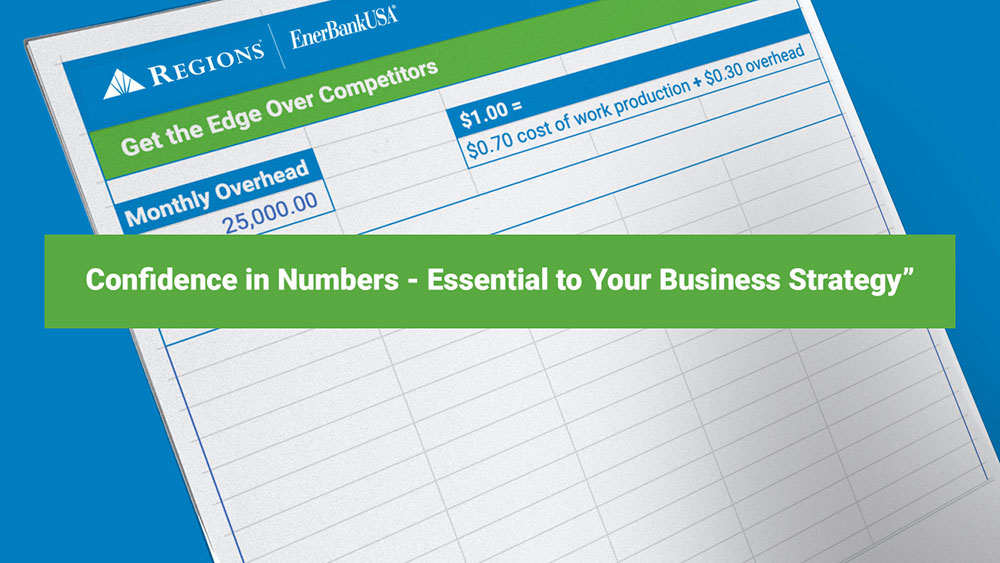Know Your Numbers – Business 101

Why is it important to know if you’re pricing your services correctly? You want to be as profitable as possible, and if your numbers are off by even a little, it could lead to some big business mistakes. A lot of contractors don’t really know their numbers like they think they do. We want to help you grow your business, and part of doing that is making sure you’re set up financially.
So, do you really have confidence in your numbers?
We recently hosted a webinar where our special guest Tom Reber broke down the essentials of understanding your numbers so that you can make the best decisions for your contracting business.
Calculating Overhead
Overhead is the opposite of income. It’s anything that your business is paying for, even if you don’t produce any jobs for the month. It doesn’t include things like field labor, materials, permits, rentals. Those items are not overhead, they’re part of your job cost. Overhead is the stuff that you have to pay out regardless of whether you have any work happening. This includes building rent, your office manager’s salary, the marketing that you’re doing, your vehicle payments — anything that still gets paid, even if you’re not producing work.
For example, my overhead might be twenty-five grand a month. I’m producing work, and for every dollar that comes in, it’s costing me 70 cents to produce the work. This leaves me 30 cents. Or, you might say that for every $100 you earn, $30 is left to pay all the overhead. When you calculate that out, you see that you have to bring in about a million dollars a year in business. Now you apply the profit percentage you want to make, your average project size, and recalculate to figure out how many jobs you have to sell to get where you want to be.

Profit Numbers
Figuring this out is the lowest hanging fruit for any contracting business. This is because it’s easy and it works great for determining your pricing. Many contracting business owners don’t have a clear idea of what their gross profit is. Tom recommends going back and job costing your last five or ten projects, and figuring out the real cost of producing your work. That will help you get your breakeven point.
Gross profit is really where the tables can turn for you. Tom aims for 50% gross profit, so if it costs a dollar, he charges at least two dollars. On the production side, you have to have the efficiencies and the training in place to produce it at the 50% profit level. This leaves more money to pay your overhead and have a net profit. Tom uses a calculator tool to easily determine what you need to do to reach the 50% gross profit level.
“Most contractors that I’ve worked with — myself included — ran away from the numbers. We care about what the going rate is. When I started my first painting company, I just priced what my uncle priced because he was a painter. And that’s what many of us do. Or, the word on the street is, you figure out what the job costs, then add 10%. There’s all these different things out there that are leading contractors astray. But the bottom line is most contractors don’t know their numbers.” – Tom Reber
Knowing your numbers is the key to getting off the hamster wheel. Now you can really start to build your business with confidence and success.
To experience both virtual and in-person events like this with Regions | EnerBank, follow us on social media for updates!
—————————————————————————————————————-
Want More Context? Here’s a Transcription of the Relevant Portion of the Webinar.
I have a question for you right now. If we had a conversation with your actions over the last 30 days, what would we learn about you? What you would’ve learned about me before I went toe to toe with this stuff Many years ago, what you would’ve seen in me would be inconsistency and insecurity. I’d say I was gonna do something, but I wouldn’t honor it because I still had that baggage rolling around.
A lot of you right now are saying you want to grow your business. You want to grow your profits, you wanna recruit a team. So, pick one of those outcomes that you want. If you look back over the last 30 days, what do your actions say about you? If you say, I wanna hire somebody, I need a foreman for my company, and then we look back and have a conversation with your actions over the last 30 days, would we prove that you’re full of garbage? Or would it confirm what you say you really want? See, a lot of people say they want something, but when you have a conversation with their actions, you guys, it doesn’t match up. All right?
So I wanna encourage you to be very clear about the outcomes that you want in your business. And we’re gonna get a little tactical here on three main areas, three main areas that I believe if you get confidence in these, if you nail these with absolute clarity of what you want and the daily actions that support them, your business in the next 90 days will be in a different place. The next 365 days will be in a very, very, very different place, in a good way. All the success that you want as a contractor, the foundation of it is what we call confidence in numbers.
Most contractors that I’ve worked with, self-included, ran away from the numbers we gave. We care about what the going rate is. You know, like me, when I started my first painting company, I just priced what my uncle priced cuz he was a painter. And that’s what many of us do. Or the word on the street is, oh, you figure out what the job costs, then you add 10%. All right? There’s all these different things out there that are leading contractors astray. But the bottom line is most contractors don’t know their numbers.
Most contractors have zero idea how much money they need to deposit into the bank each month to just break even, not even make a net profit. And we’re gonna dig into some of that here today, guys, your breakeven point, okay? And this, this confuses some people. If you’re a little confused on this, that’s okay. I want to just acknowledge it took me about 18 months to fully figure this breakeven thing out, okay? And, um, but it’s okay, but I think it’s gonna really inspire you to learn what it means to have confidence in your numbers.
So your breakeven point for the money each month is your monthly overhead divided by what your actual produced gross profit is.
So crash course on gross profit. If I sell a job for 10 grand and the job costs me five grand to produce 10,000 minus the five, I got five grand left, that’s 50% of the money, that’s a 50% gross profit.
If that same job is 10 grand and it costs me $7,000 to produce, that means I got three grand left. That’s a 30% gross profit. The higher your gross profit, the better your life is gonna be financially. All right?
It’s the lowest hanging fruit for any contracting business right now. Most contracting business have no idea what their gross profit is. So I encourage you to go back and job cost your last five or 10 projects and figure out what you’re producing your work at, and that’ll help you get your breakeven point. All right? 50% gross profit is what I aim for. So basically, if it costs me a dollar, I charge at least $2. And then on the production side, you have to have the efficiencies and the training in place to produce it at the 50%, and that leaves more money to pay your overhead and have a net profit.
So let’s say your monthly overhead and your business is 25,000 bucks. Now, in my world, your owner’s salary is part of the overhead, all right? So again, I just want to be clear, an overhead is anything that has to be paid in the business, even if you don’t produce any jobs this month, okay? Because your field labor, materials, permits, those types of things, equipment, rentals, blah, blah, blah, all those things are cost to good sold — those are not overhead, okay? Overhead is your building rent your salary office per office manager’s salary, the marketing that you’re doing, your vehicle payments, your cell phones, you know, anything that still gets paid, even if you’re not producing work, that’s overhead.
So guys, if my overhead is 25 grand a month and I’m producing my work, let’s just use the example I used before at a 30%. Meaning for every dollar that comes in, it’s costing me 70 cents to produce the work, leaving me 30 cents. Or for every hundred dollars that comes in, I have $30 left to pay all the overhead. That’s what this means. You need to bring in basically a million bucks a year, okay? But 30 you gotta deposit into the bank, 83 grand to keep, 25 grand if you’re only running at a 30% gross profit.
Now, when you get a 50% gross profit, you only need to bring in 50,000 bucks. So if you’re at a 30 now and you go to a 40, you say from now we’re gonna inch it up to a 40 instead of 83 grand, you gotta bring in 62 grand and deposit it. All right?
So the higher your gross profit, the lower your breakeven point is.
Now, we’re gonna talk about how to raise gross profit here in a minute. But guys, this, what’s, this is what starts with confidence in numbers. You have to understand all the reasons why a higher gross profit is ethical. It’s better for you, it’s better for the client, and it’s fair to everyone.
Too many contractors are undercharging and they’re delivering a garbage experience to people, which is why a lot of contractors have a bad reputation. Too many contractors are on the hamster wheel of just volume and volume and volume, and they have no money left at the end of the year, and they’re just tired and they’re repeating the same year over and over.
All right? So like I said earlier, in our community, the standard is 50%. And that’s where we encourage everybody to get. And those are the things that truly allow you to hire more people, hire more talented people, do more training, invest in your marketing, actually build a retirement for yourself, and build a real business.
Transcript from the 6/15/2023 “Winning the Contractor Fight” webinar with Tom Reber
Blog Archives
No posts for Dec, 2024




